Palliative Care Case Study (pdf)
VerifiedAdded on 2021/02/19
|10
|2930
|38
AI Summary
Contribute Materials
Your contribution can guide someone’s learning journey. Share your
documents today.
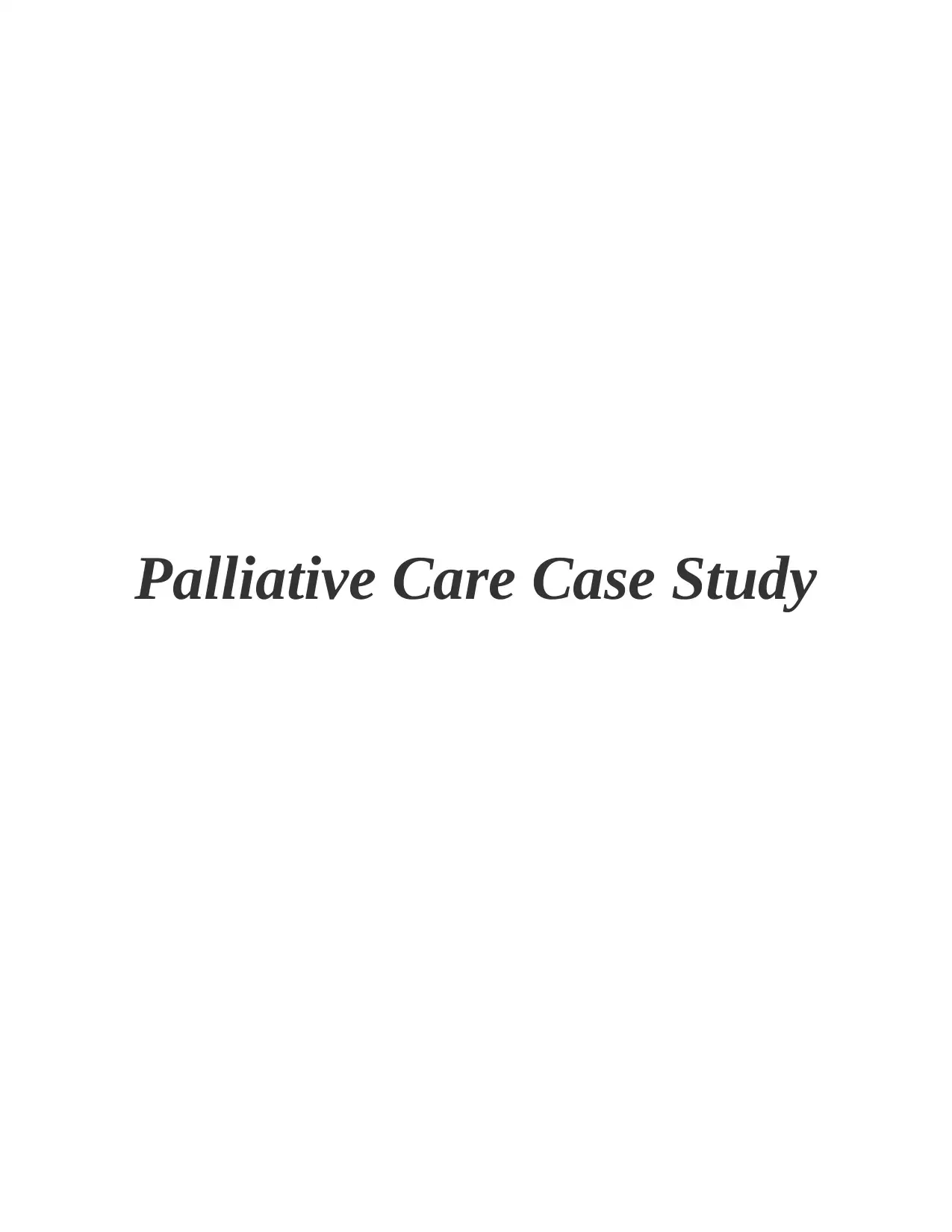
Palliative Care Case Study
Secure Best Marks with AI Grader
Need help grading? Try our AI Grader for instant feedback on your assignments.


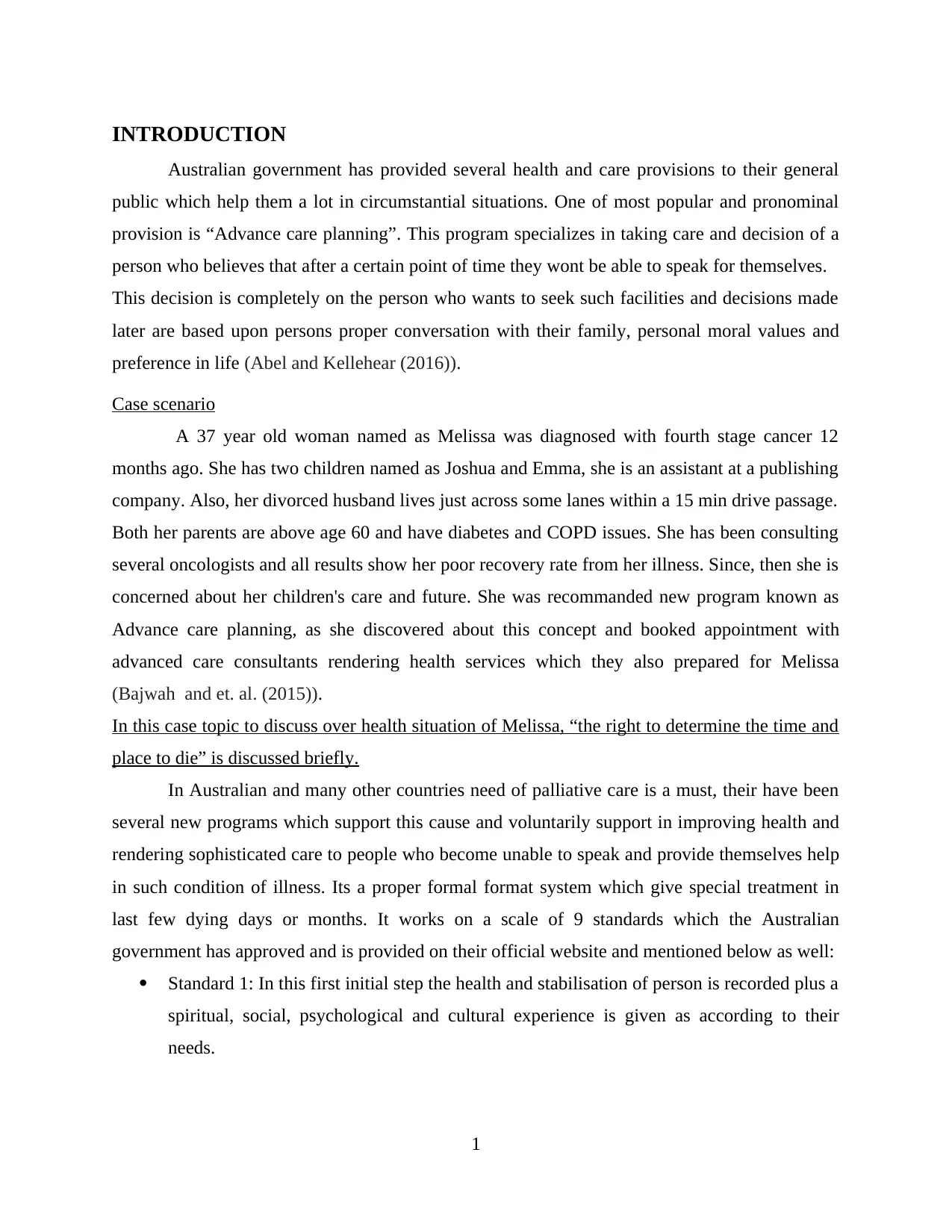
INTRODUCTION
Australian government has provided several health and care provisions to their general
public which help them a lot in circumstantial situations. One of most popular and pronominal
provision is “Advance care planning”. This program specializes in taking care and decision of a
person who believes that after a certain point of time they wont be able to speak for themselves.
This decision is completely on the person who wants to seek such facilities and decisions made
later are based upon persons proper conversation with their family, personal moral values and
preference in life (Abel and Kellehear (2016)).
Case scenario
A 37 year old woman named as Melissa was diagnosed with fourth stage cancer 12
months ago. She has two children named as Joshua and Emma, she is an assistant at a publishing
company. Also, her divorced husband lives just across some lanes within a 15 min drive passage.
Both her parents are above age 60 and have diabetes and COPD issues. She has been consulting
several oncologists and all results show her poor recovery rate from her illness. Since, then she is
concerned about her children's care and future. She was recommanded new program known as
Advance care planning, as she discovered about this concept and booked appointment with
advanced care consultants rendering health services which they also prepared for Melissa
(Bajwah and et. al. (2015)).
In this case topic to discuss over health situation of Melissa, “the right to determine the time and
place to die” is discussed briefly.
In Australian and many other countries need of palliative care is a must, their have been
several new programs which support this cause and voluntarily support in improving health and
rendering sophisticated care to people who become unable to speak and provide themselves help
in such condition of illness. Its a proper formal format system which give special treatment in
last few dying days or months. It works on a scale of 9 standards which the Australian
government has approved and is provided on their official website and mentioned below as well:
Standard 1: In this first initial step the health and stabilisation of person is recorded plus a
spiritual, social, psychological and cultural experience is given as according to their
needs.
1
Australian government has provided several health and care provisions to their general
public which help them a lot in circumstantial situations. One of most popular and pronominal
provision is “Advance care planning”. This program specializes in taking care and decision of a
person who believes that after a certain point of time they wont be able to speak for themselves.
This decision is completely on the person who wants to seek such facilities and decisions made
later are based upon persons proper conversation with their family, personal moral values and
preference in life (Abel and Kellehear (2016)).
Case scenario
A 37 year old woman named as Melissa was diagnosed with fourth stage cancer 12
months ago. She has two children named as Joshua and Emma, she is an assistant at a publishing
company. Also, her divorced husband lives just across some lanes within a 15 min drive passage.
Both her parents are above age 60 and have diabetes and COPD issues. She has been consulting
several oncologists and all results show her poor recovery rate from her illness. Since, then she is
concerned about her children's care and future. She was recommanded new program known as
Advance care planning, as she discovered about this concept and booked appointment with
advanced care consultants rendering health services which they also prepared for Melissa
(Bajwah and et. al. (2015)).
In this case topic to discuss over health situation of Melissa, “the right to determine the time and
place to die” is discussed briefly.
In Australian and many other countries need of palliative care is a must, their have been
several new programs which support this cause and voluntarily support in improving health and
rendering sophisticated care to people who become unable to speak and provide themselves help
in such condition of illness. Its a proper formal format system which give special treatment in
last few dying days or months. It works on a scale of 9 standards which the Australian
government has approved and is provided on their official website and mentioned below as well:
Standard 1: In this first initial step the health and stabilisation of person is recorded plus a
spiritual, social, psychological and cultural experience is given as according to their
needs.
1
Secure Best Marks with AI Grader
Need help grading? Try our AI Grader for instant feedback on your assignments.
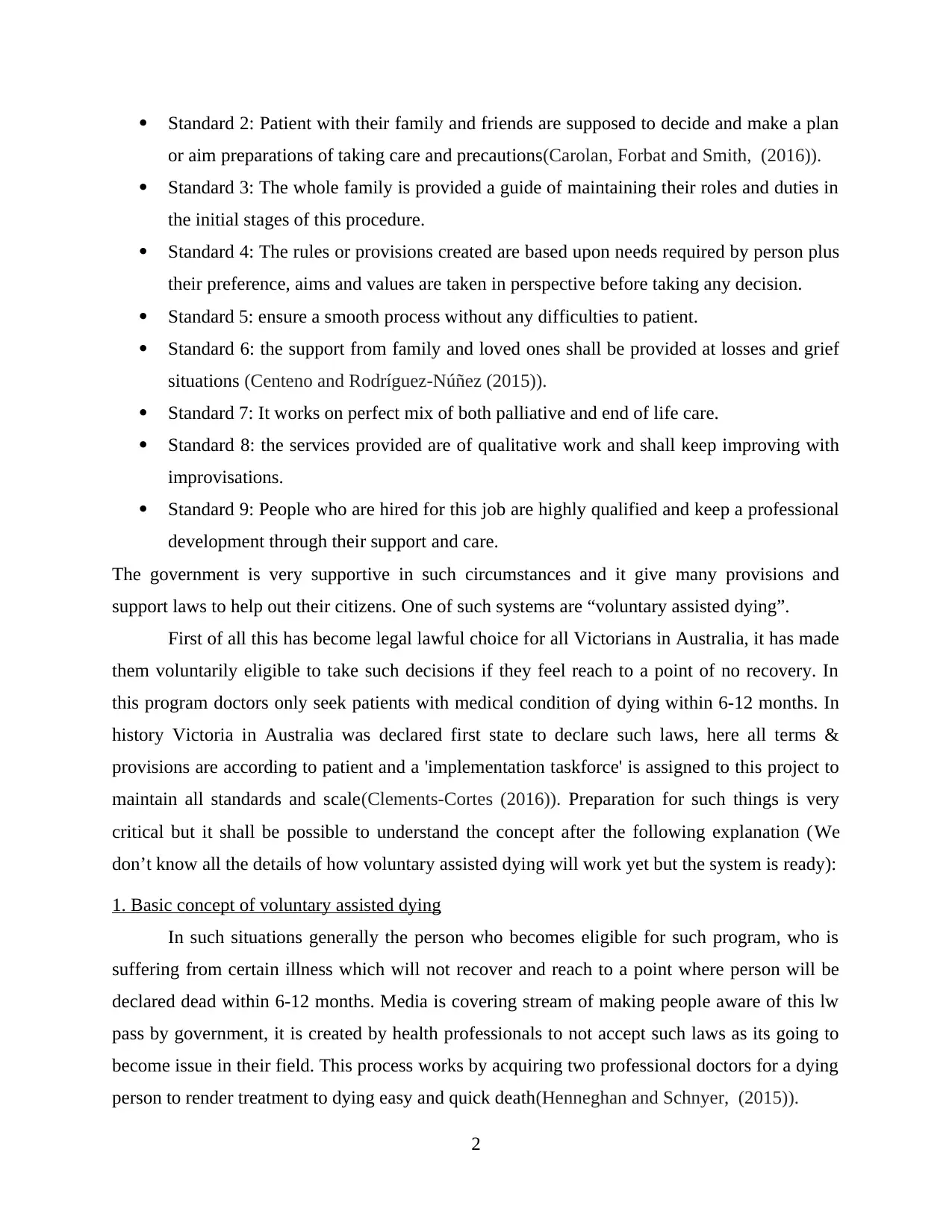
Standard 2: Patient with their family and friends are supposed to decide and make a plan
or aim preparations of taking care and precautions(Carolan, Forbat and Smith, (2016)).
Standard 3: The whole family is provided a guide of maintaining their roles and duties in
the initial stages of this procedure.
Standard 4: The rules or provisions created are based upon needs required by person plus
their preference, aims and values are taken in perspective before taking any decision.
Standard 5: ensure a smooth process without any difficulties to patient.
Standard 6: the support from family and loved ones shall be provided at losses and grief
situations (Centeno and Rodríguez-Núñez (2015)).
Standard 7: It works on perfect mix of both palliative and end of life care.
Standard 8: the services provided are of qualitative work and shall keep improving with
improvisations.
Standard 9: People who are hired for this job are highly qualified and keep a professional
development through their support and care.
The government is very supportive in such circumstances and it give many provisions and
support laws to help out their citizens. One of such systems are “voluntary assisted dying”.
First of all this has become legal lawful choice for all Victorians in Australia, it has made
them voluntarily eligible to take such decisions if they feel reach to a point of no recovery. In
this program doctors only seek patients with medical condition of dying within 6-12 months. In
history Victoria in Australia was declared first state to declare such laws, here all terms &
provisions are according to patient and a 'implementation taskforce' is assigned to this project to
maintain all standards and scale(Clements-Cortes (2016)). Preparation for such things is very
critical but it shall be possible to understand the concept after the following explanation (We
don’t know all the details of how voluntary assisted dying will work yet but the system is ready):
1. Basic concept of voluntary assisted dying
In such situations generally the person who becomes eligible for such program, who is
suffering from certain illness which will not recover and reach to a point where person will be
declared dead within 6-12 months. Media is covering stream of making people aware of this lw
pass by government, it is created by health professionals to not accept such laws as its going to
become issue in their field. This process works by acquiring two professional doctors for a dying
person to render treatment to dying easy and quick death(Henneghan and Schnyer, (2015)).
2
or aim preparations of taking care and precautions(Carolan, Forbat and Smith, (2016)).
Standard 3: The whole family is provided a guide of maintaining their roles and duties in
the initial stages of this procedure.
Standard 4: The rules or provisions created are based upon needs required by person plus
their preference, aims and values are taken in perspective before taking any decision.
Standard 5: ensure a smooth process without any difficulties to patient.
Standard 6: the support from family and loved ones shall be provided at losses and grief
situations (Centeno and Rodríguez-Núñez (2015)).
Standard 7: It works on perfect mix of both palliative and end of life care.
Standard 8: the services provided are of qualitative work and shall keep improving with
improvisations.
Standard 9: People who are hired for this job are highly qualified and keep a professional
development through their support and care.
The government is very supportive in such circumstances and it give many provisions and
support laws to help out their citizens. One of such systems are “voluntary assisted dying”.
First of all this has become legal lawful choice for all Victorians in Australia, it has made
them voluntarily eligible to take such decisions if they feel reach to a point of no recovery. In
this program doctors only seek patients with medical condition of dying within 6-12 months. In
history Victoria in Australia was declared first state to declare such laws, here all terms &
provisions are according to patient and a 'implementation taskforce' is assigned to this project to
maintain all standards and scale(Clements-Cortes (2016)). Preparation for such things is very
critical but it shall be possible to understand the concept after the following explanation (We
don’t know all the details of how voluntary assisted dying will work yet but the system is ready):
1. Basic concept of voluntary assisted dying
In such situations generally the person who becomes eligible for such program, who is
suffering from certain illness which will not recover and reach to a point where person will be
declared dead within 6-12 months. Media is covering stream of making people aware of this lw
pass by government, it is created by health professionals to not accept such laws as its going to
become issue in their field. This process works by acquiring two professional doctors for a dying
person to render treatment to dying easy and quick death(Henneghan and Schnyer, (2015)).
2
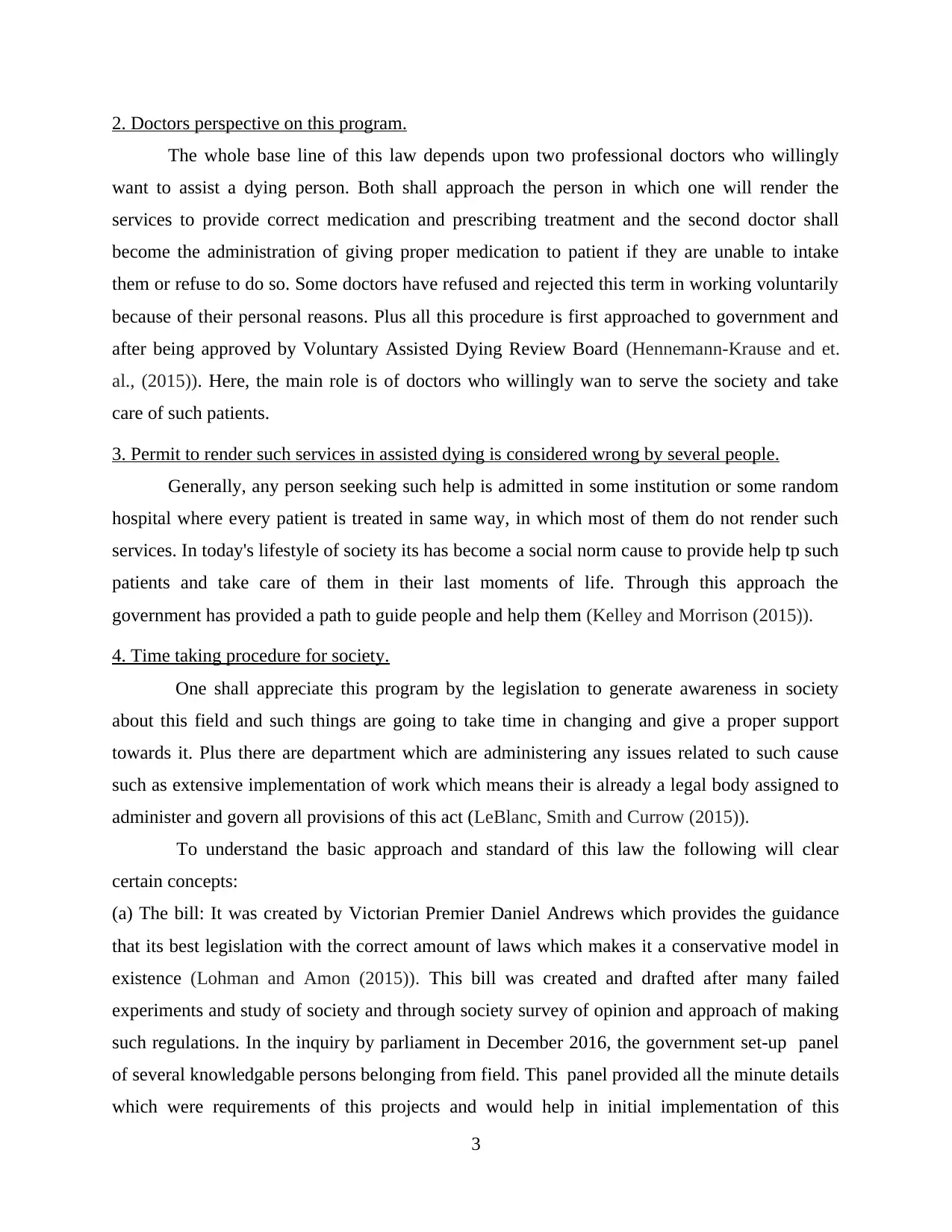
2. Doctors perspective on this program.
The whole base line of this law depends upon two professional doctors who willingly
want to assist a dying person. Both shall approach the person in which one will render the
services to provide correct medication and prescribing treatment and the second doctor shall
become the administration of giving proper medication to patient if they are unable to intake
them or refuse to do so. Some doctors have refused and rejected this term in working voluntarily
because of their personal reasons. Plus all this procedure is first approached to government and
after being approved by Voluntary Assisted Dying Review Board (Hennemann-Krause and et.
al., (2015)). Here, the main role is of doctors who willingly wan to serve the society and take
care of such patients.
3. Permit to render such services in assisted dying is considered wrong by several people.
Generally, any person seeking such help is admitted in some institution or some random
hospital where every patient is treated in same way, in which most of them do not render such
services. In today's lifestyle of society its has become a social norm cause to provide help tp such
patients and take care of them in their last moments of life. Through this approach the
government has provided a path to guide people and help them (Kelley and Morrison (2015)).
4. Time taking procedure for society.
One shall appreciate this program by the legislation to generate awareness in society
about this field and such things are going to take time in changing and give a proper support
towards it. Plus there are department which are administering any issues related to such cause
such as extensive implementation of work which means their is already a legal body assigned to
administer and govern all provisions of this act (LeBlanc, Smith and Currow (2015)).
To understand the basic approach and standard of this law the following will clear
certain concepts:
(a) The bill: It was created by Victorian Premier Daniel Andrews which provides the guidance
that its best legislation with the correct amount of laws which makes it a conservative model in
existence (Lohman and Amon (2015)). This bill was created and drafted after many failed
experiments and study of society and through society survey of opinion and approach of making
such regulations. In the inquiry by parliament in December 2016, the government set-up panel
of several knowledgable persons belonging from field. This panel provided all the minute details
which were requirements of this projects and would help in initial implementation of this
3
The whole base line of this law depends upon two professional doctors who willingly
want to assist a dying person. Both shall approach the person in which one will render the
services to provide correct medication and prescribing treatment and the second doctor shall
become the administration of giving proper medication to patient if they are unable to intake
them or refuse to do so. Some doctors have refused and rejected this term in working voluntarily
because of their personal reasons. Plus all this procedure is first approached to government and
after being approved by Voluntary Assisted Dying Review Board (Hennemann-Krause and et.
al., (2015)). Here, the main role is of doctors who willingly wan to serve the society and take
care of such patients.
3. Permit to render such services in assisted dying is considered wrong by several people.
Generally, any person seeking such help is admitted in some institution or some random
hospital where every patient is treated in same way, in which most of them do not render such
services. In today's lifestyle of society its has become a social norm cause to provide help tp such
patients and take care of them in their last moments of life. Through this approach the
government has provided a path to guide people and help them (Kelley and Morrison (2015)).
4. Time taking procedure for society.
One shall appreciate this program by the legislation to generate awareness in society
about this field and such things are going to take time in changing and give a proper support
towards it. Plus there are department which are administering any issues related to such cause
such as extensive implementation of work which means their is already a legal body assigned to
administer and govern all provisions of this act (LeBlanc, Smith and Currow (2015)).
To understand the basic approach and standard of this law the following will clear
certain concepts:
(a) The bill: It was created by Victorian Premier Daniel Andrews which provides the guidance
that its best legislation with the correct amount of laws which makes it a conservative model in
existence (Lohman and Amon (2015)). This bill was created and drafted after many failed
experiments and study of society and through society survey of opinion and approach of making
such regulations. In the inquiry by parliament in December 2016, the government set-up panel
of several knowledgable persons belonging from field. This panel provided all the minute details
which were requirements of this projects and would help in initial implementation of this
3
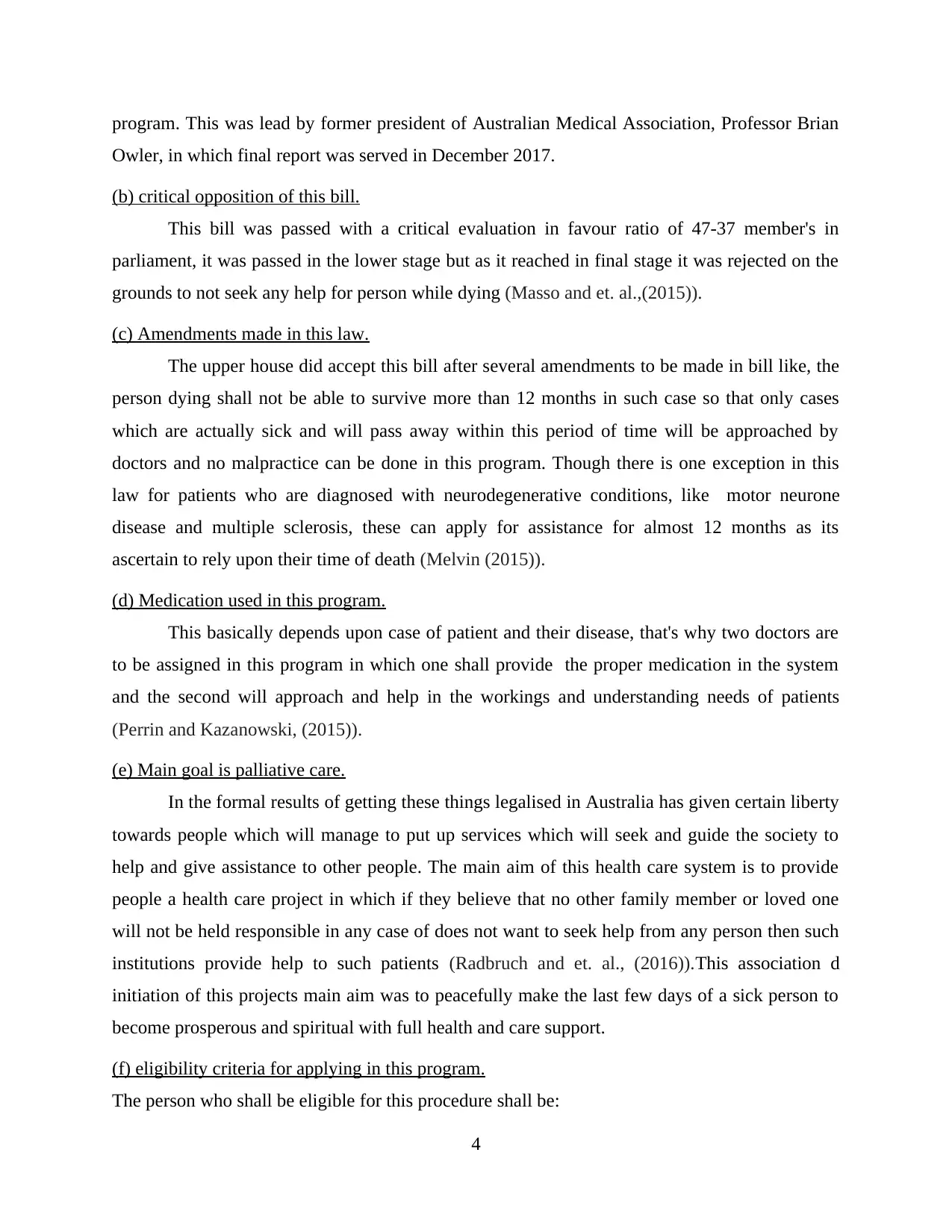
program. This was lead by former president of Australian Medical Association, Professor Brian
Owler, in which final report was served in December 2017.
(b) critical opposition of this bill.
This bill was passed with a critical evaluation in favour ratio of 47-37 member's in
parliament, it was passed in the lower stage but as it reached in final stage it was rejected on the
grounds to not seek any help for person while dying (Masso and et. al.,(2015)).
(c) Amendments made in this law.
The upper house did accept this bill after several amendments to be made in bill like, the
person dying shall not be able to survive more than 12 months in such case so that only cases
which are actually sick and will pass away within this period of time will be approached by
doctors and no malpractice can be done in this program. Though there is one exception in this
law for patients who are diagnosed with neurodegenerative conditions, like motor neurone
disease and multiple sclerosis, these can apply for assistance for almost 12 months as its
ascertain to rely upon their time of death (Melvin (2015)).
(d) Medication used in this program.
This basically depends upon case of patient and their disease, that's why two doctors are
to be assigned in this program in which one shall provide the proper medication in the system
and the second will approach and help in the workings and understanding needs of patients
(Perrin and Kazanowski, (2015)).
(e) Main goal is palliative care.
In the formal results of getting these things legalised in Australia has given certain liberty
towards people which will manage to put up services which will seek and guide the society to
help and give assistance to other people. The main aim of this health care system is to provide
people a health care project in which if they believe that no other family member or loved one
will not be held responsible in any case of does not want to seek help from any person then such
institutions provide help to such patients (Radbruch and et. al., (2016)).This association d
initiation of this projects main aim was to peacefully make the last few days of a sick person to
become prosperous and spiritual with full health and care support.
(f) eligibility criteria for applying in this program.
The person who shall be eligible for this procedure shall be:
4
Owler, in which final report was served in December 2017.
(b) critical opposition of this bill.
This bill was passed with a critical evaluation in favour ratio of 47-37 member's in
parliament, it was passed in the lower stage but as it reached in final stage it was rejected on the
grounds to not seek any help for person while dying (Masso and et. al.,(2015)).
(c) Amendments made in this law.
The upper house did accept this bill after several amendments to be made in bill like, the
person dying shall not be able to survive more than 12 months in such case so that only cases
which are actually sick and will pass away within this period of time will be approached by
doctors and no malpractice can be done in this program. Though there is one exception in this
law for patients who are diagnosed with neurodegenerative conditions, like motor neurone
disease and multiple sclerosis, these can apply for assistance for almost 12 months as its
ascertain to rely upon their time of death (Melvin (2015)).
(d) Medication used in this program.
This basically depends upon case of patient and their disease, that's why two doctors are
to be assigned in this program in which one shall provide the proper medication in the system
and the second will approach and help in the workings and understanding needs of patients
(Perrin and Kazanowski, (2015)).
(e) Main goal is palliative care.
In the formal results of getting these things legalised in Australia has given certain liberty
towards people which will manage to put up services which will seek and guide the society to
help and give assistance to other people. The main aim of this health care system is to provide
people a health care project in which if they believe that no other family member or loved one
will not be held responsible in any case of does not want to seek help from any person then such
institutions provide help to such patients (Radbruch and et. al., (2016)).This association d
initiation of this projects main aim was to peacefully make the last few days of a sick person to
become prosperous and spiritual with full health and care support.
(f) eligibility criteria for applying in this program.
The person who shall be eligible for this procedure shall be:
4
Paraphrase This Document
Need a fresh take? Get an instant paraphrase of this document with our AI Paraphraser
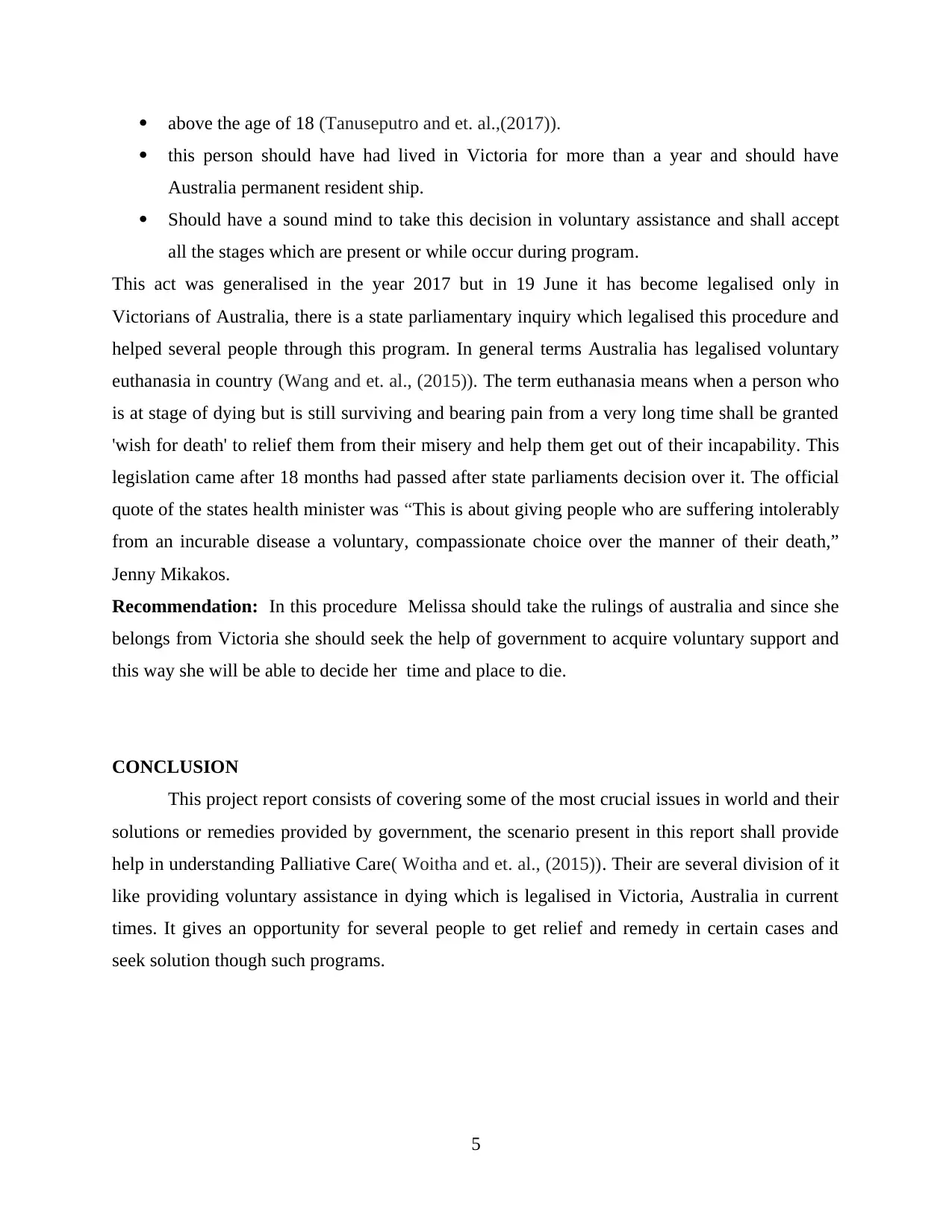
above the age of 18 (Tanuseputro and et. al.,(2017)).
this person should have had lived in Victoria for more than a year and should have
Australia permanent resident ship.
Should have a sound mind to take this decision in voluntary assistance and shall accept
all the stages which are present or while occur during program.
This act was generalised in the year 2017 but in 19 June it has become legalised only in
Victorians of Australia, there is a state parliamentary inquiry which legalised this procedure and
helped several people through this program. In general terms Australia has legalised voluntary
euthanasia in country (Wang and et. al., (2015)). The term euthanasia means when a person who
is at stage of dying but is still surviving and bearing pain from a very long time shall be granted
'wish for death' to relief them from their misery and help them get out of their incapability. This
legislation came after 18 months had passed after state parliaments decision over it. The official
quote of the states health minister was “This is about giving people who are suffering intolerably
from an incurable disease a voluntary, compassionate choice over the manner of their death,”
Jenny Mikakos.
Recommendation: In this procedure Melissa should take the rulings of australia and since she
belongs from Victoria she should seek the help of government to acquire voluntary support and
this way she will be able to decide her time and place to die.
CONCLUSION
This project report consists of covering some of the most crucial issues in world and their
solutions or remedies provided by government, the scenario present in this report shall provide
help in understanding Palliative Care( Woitha and et. al., (2015)). Their are several division of it
like providing voluntary assistance in dying which is legalised in Victoria, Australia in current
times. It gives an opportunity for several people to get relief and remedy in certain cases and
seek solution though such programs.
5
this person should have had lived in Victoria for more than a year and should have
Australia permanent resident ship.
Should have a sound mind to take this decision in voluntary assistance and shall accept
all the stages which are present or while occur during program.
This act was generalised in the year 2017 but in 19 June it has become legalised only in
Victorians of Australia, there is a state parliamentary inquiry which legalised this procedure and
helped several people through this program. In general terms Australia has legalised voluntary
euthanasia in country (Wang and et. al., (2015)). The term euthanasia means when a person who
is at stage of dying but is still surviving and bearing pain from a very long time shall be granted
'wish for death' to relief them from their misery and help them get out of their incapability. This
legislation came after 18 months had passed after state parliaments decision over it. The official
quote of the states health minister was “This is about giving people who are suffering intolerably
from an incurable disease a voluntary, compassionate choice over the manner of their death,”
Jenny Mikakos.
Recommendation: In this procedure Melissa should take the rulings of australia and since she
belongs from Victoria she should seek the help of government to acquire voluntary support and
this way she will be able to decide her time and place to die.
CONCLUSION
This project report consists of covering some of the most crucial issues in world and their
solutions or remedies provided by government, the scenario present in this report shall provide
help in understanding Palliative Care( Woitha and et. al., (2015)). Their are several division of it
like providing voluntary assistance in dying which is legalised in Victoria, Australia in current
times. It gives an opportunity for several people to get relief and remedy in certain cases and
seek solution though such programs.
5
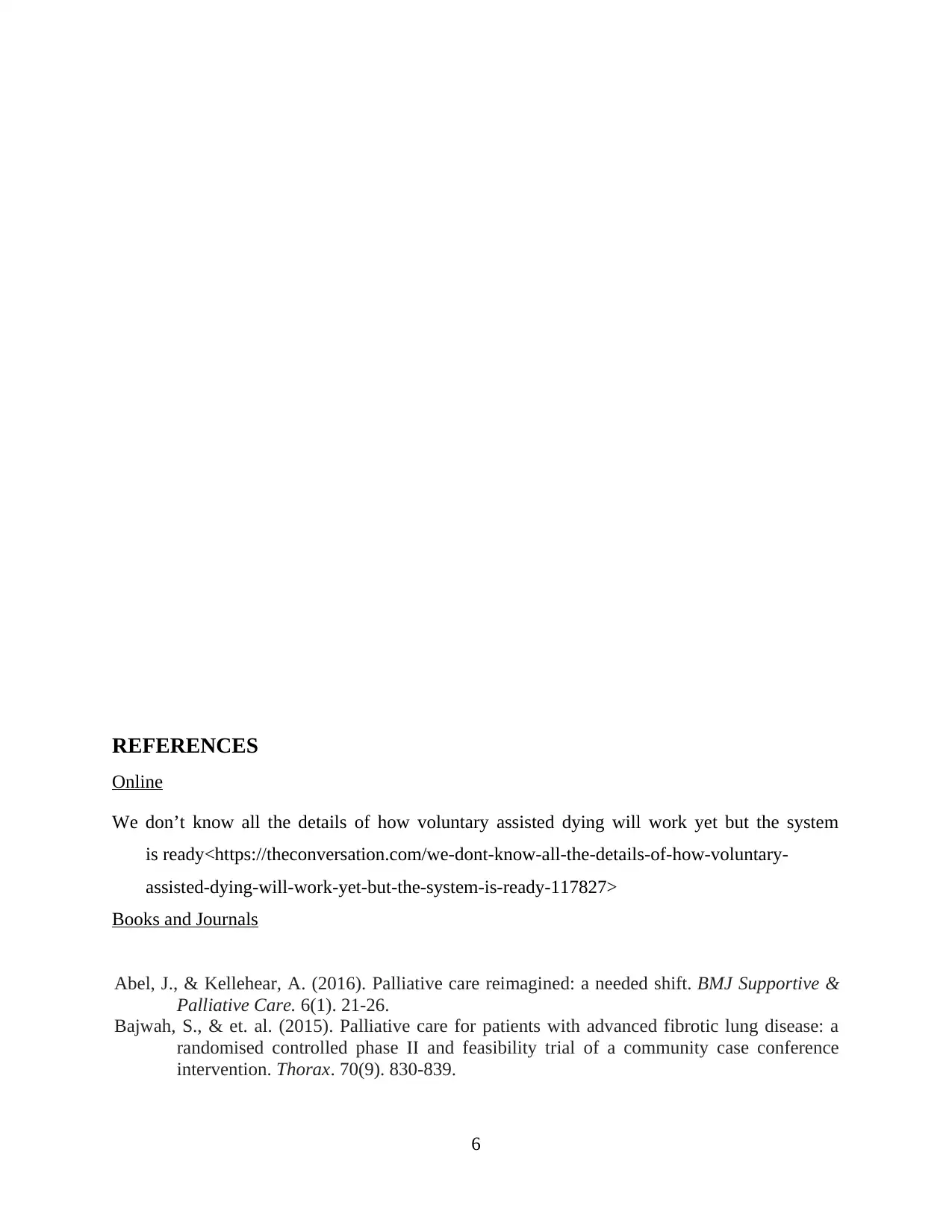
REFERENCES
Online
We don’t know all the details of how voluntary assisted dying will work yet but the system
is ready<https://theconversation.com/we-dont-know-all-the-details-of-how-voluntary-
assisted-dying-will-work-yet-but-the-system-is-ready-117827>
Books and Journals
Abel, J., & Kellehear, A. (2016). Palliative care reimagined: a needed shift. BMJ Supportive &
Palliative Care. 6(1). 21-26.
Bajwah, S., & et. al. (2015). Palliative care for patients with advanced fibrotic lung disease: a
randomised controlled phase II and feasibility trial of a community case conference
intervention. Thorax. 70(9). 830-839.
6
Online
We don’t know all the details of how voluntary assisted dying will work yet but the system
is ready<https://theconversation.com/we-dont-know-all-the-details-of-how-voluntary-
assisted-dying-will-work-yet-but-the-system-is-ready-117827>
Books and Journals
Abel, J., & Kellehear, A. (2016). Palliative care reimagined: a needed shift. BMJ Supportive &
Palliative Care. 6(1). 21-26.
Bajwah, S., & et. al. (2015). Palliative care for patients with advanced fibrotic lung disease: a
randomised controlled phase II and feasibility trial of a community case conference
intervention. Thorax. 70(9). 830-839.
6
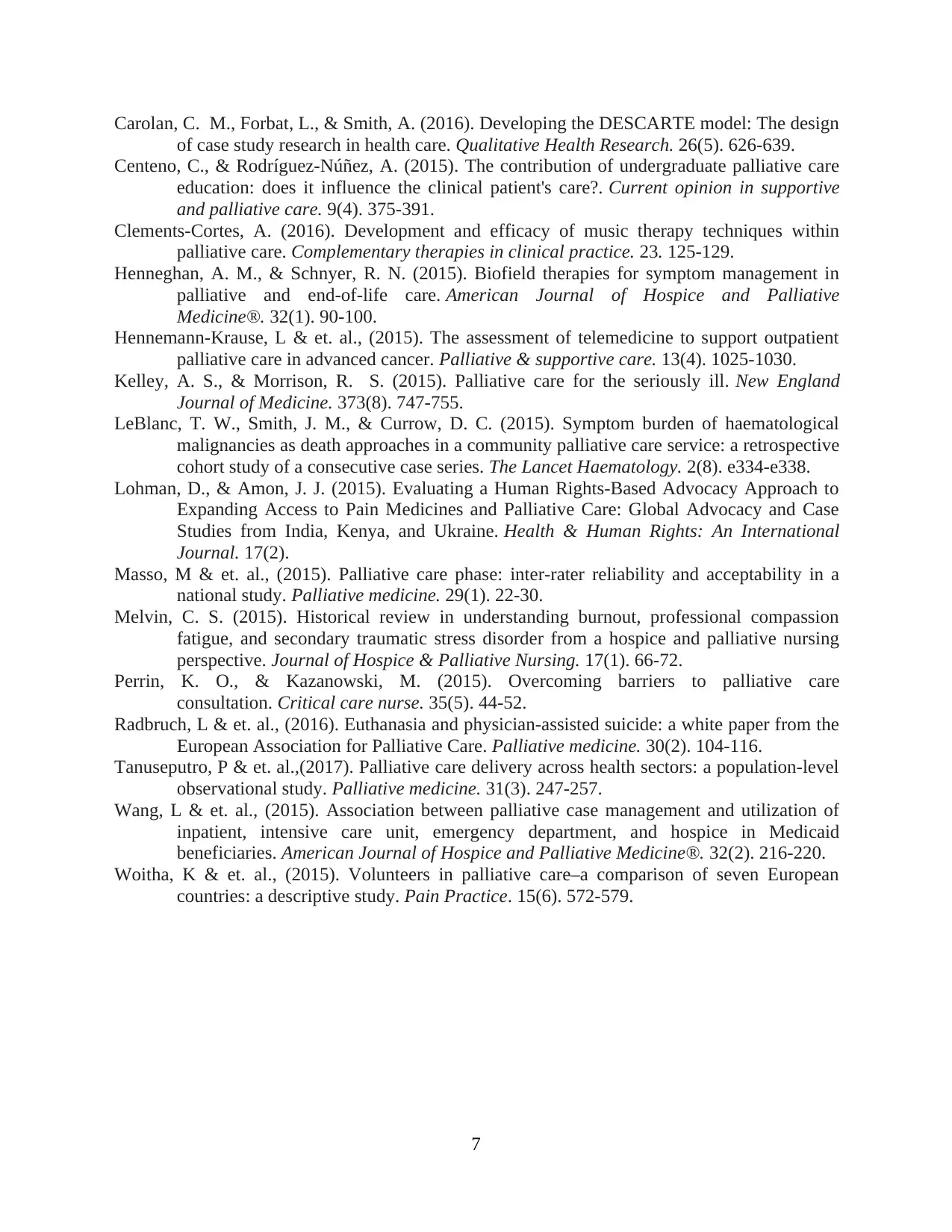
Carolan, C. M., Forbat, L., & Smith, A. (2016). Developing the DESCARTE model: The design
of case study research in health care. Qualitative Health Research. 26(5). 626-639.
Centeno, C., & Rodríguez-Núñez, A. (2015). The contribution of undergraduate palliative care
education: does it influence the clinical patient's care?. Current opinion in supportive
and palliative care. 9(4). 375-391.
Clements-Cortes, A. (2016). Development and efficacy of music therapy techniques within
palliative care. Complementary therapies in clinical practice. 23. 125-129.
Henneghan, A. M., & Schnyer, R. N. (2015). Biofield therapies for symptom management in
palliative and end-of-life care. American Journal of Hospice and Palliative
Medicine®. 32(1). 90-100.
Hennemann-Krause, L & et. al., (2015). The assessment of telemedicine to support outpatient
palliative care in advanced cancer. Palliative & supportive care. 13(4). 1025-1030.
Kelley, A. S., & Morrison, R. S. (2015). Palliative care for the seriously ill. New England
Journal of Medicine. 373(8). 747-755.
LeBlanc, T. W., Smith, J. M., & Currow, D. C. (2015). Symptom burden of haematological
malignancies as death approaches in a community palliative care service: a retrospective
cohort study of a consecutive case series. The Lancet Haematology. 2(8). e334-e338.
Lohman, D., & Amon, J. J. (2015). Evaluating a Human Rights-Based Advocacy Approach to
Expanding Access to Pain Medicines and Palliative Care: Global Advocacy and Case
Studies from India, Kenya, and Ukraine. Health & Human Rights: An International
Journal. 17(2).
Masso, M & et. al., (2015). Palliative care phase: inter-rater reliability and acceptability in a
national study. Palliative medicine. 29(1). 22-30.
Melvin, C. S. (2015). Historical review in understanding burnout, professional compassion
fatigue, and secondary traumatic stress disorder from a hospice and palliative nursing
perspective. Journal of Hospice & Palliative Nursing. 17(1). 66-72.
Perrin, K. O., & Kazanowski, M. (2015). Overcoming barriers to palliative care
consultation. Critical care nurse. 35(5). 44-52.
Radbruch, L & et. al., (2016). Euthanasia and physician-assisted suicide: a white paper from the
European Association for Palliative Care. Palliative medicine. 30(2). 104-116.
Tanuseputro, P & et. al.,(2017). Palliative care delivery across health sectors: a population-level
observational study. Palliative medicine. 31(3). 247-257.
Wang, L & et. al., (2015). Association between palliative case management and utilization of
inpatient, intensive care unit, emergency department, and hospice in Medicaid
beneficiaries. American Journal of Hospice and Palliative Medicine®. 32(2). 216-220.
Woitha, K & et. al., (2015). Volunteers in palliative care–a comparison of seven European
countries: a descriptive study. Pain Practice. 15(6). 572-579.
7
of case study research in health care. Qualitative Health Research. 26(5). 626-639.
Centeno, C., & Rodríguez-Núñez, A. (2015). The contribution of undergraduate palliative care
education: does it influence the clinical patient's care?. Current opinion in supportive
and palliative care. 9(4). 375-391.
Clements-Cortes, A. (2016). Development and efficacy of music therapy techniques within
palliative care. Complementary therapies in clinical practice. 23. 125-129.
Henneghan, A. M., & Schnyer, R. N. (2015). Biofield therapies for symptom management in
palliative and end-of-life care. American Journal of Hospice and Palliative
Medicine®. 32(1). 90-100.
Hennemann-Krause, L & et. al., (2015). The assessment of telemedicine to support outpatient
palliative care in advanced cancer. Palliative & supportive care. 13(4). 1025-1030.
Kelley, A. S., & Morrison, R. S. (2015). Palliative care for the seriously ill. New England
Journal of Medicine. 373(8). 747-755.
LeBlanc, T. W., Smith, J. M., & Currow, D. C. (2015). Symptom burden of haematological
malignancies as death approaches in a community palliative care service: a retrospective
cohort study of a consecutive case series. The Lancet Haematology. 2(8). e334-e338.
Lohman, D., & Amon, J. J. (2015). Evaluating a Human Rights-Based Advocacy Approach to
Expanding Access to Pain Medicines and Palliative Care: Global Advocacy and Case
Studies from India, Kenya, and Ukraine. Health & Human Rights: An International
Journal. 17(2).
Masso, M & et. al., (2015). Palliative care phase: inter-rater reliability and acceptability in a
national study. Palliative medicine. 29(1). 22-30.
Melvin, C. S. (2015). Historical review in understanding burnout, professional compassion
fatigue, and secondary traumatic stress disorder from a hospice and palliative nursing
perspective. Journal of Hospice & Palliative Nursing. 17(1). 66-72.
Perrin, K. O., & Kazanowski, M. (2015). Overcoming barriers to palliative care
consultation. Critical care nurse. 35(5). 44-52.
Radbruch, L & et. al., (2016). Euthanasia and physician-assisted suicide: a white paper from the
European Association for Palliative Care. Palliative medicine. 30(2). 104-116.
Tanuseputro, P & et. al.,(2017). Palliative care delivery across health sectors: a population-level
observational study. Palliative medicine. 31(3). 247-257.
Wang, L & et. al., (2015). Association between palliative case management and utilization of
inpatient, intensive care unit, emergency department, and hospice in Medicaid
beneficiaries. American Journal of Hospice and Palliative Medicine®. 32(2). 216-220.
Woitha, K & et. al., (2015). Volunteers in palliative care–a comparison of seven European
countries: a descriptive study. Pain Practice. 15(6). 572-579.
7
1 out of 10
Related Documents
Your All-in-One AI-Powered Toolkit for Academic Success.
+13062052269
info@desklib.com
Available 24*7 on WhatsApp / Email
![[object Object]](/_next/static/media/star-bottom.7253800d.svg)
Unlock your academic potential
© 2024 | Zucol Services PVT LTD | All rights reserved.





